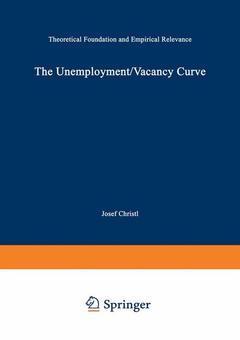Description
The Unemployment/Vacancy Curve, Softcover reprint of the original 1st ed. 1992
Theoretical Foundation and Empirical Relevance
Studies in Empirical Economics Series
Author: Christl Josef
Language: English
Subject for The Unemployment/Vacancy Curve:
Keywords
Approximative price 52.74 €
In Print (Delivery period: 15 days).
Add to cart
Publication date: 11-2012
152 p. · 14x21.6 cm · Paperback
152 p. · 14x21.6 cm · Paperback
Description
/li>Contents
/li>
Rising unemployment has become one of the most challenging problems for economic policy in many developed economies over the last fifteen years. In the second half of the 1970s and during the first half of the 1980s the labour market situation worsened dramatically. For the OECD area as a whole, unemployment as a percentage of the civilian labour force went up from 3.3 percent in 1974 to 8.1 percent in 1985. The increase in unemployment rates was even more pronounced for OECD-Europe, where it climbed from 3.3 percent to 10.5 percent in this period. Table 1.1: Unemployment Rates in some aECD Countries, 1974-1989 yearly average 1989 1974{79 1974 1979 1985 1980/85 1985/89 USA 5,6 5,8 7,2 5,2 6,8 8,1 6,2 UK 2,2 4,5 11,6 6,5 4,2 10,0 9,7 3,3 8,3 7,3 3,5 6,6 7,9 FRG 2,1 2,4 1,3 1,5 2,4 2,2 Sweden 1,6 1,7 Austria 1,1 1,7 3,6 3,4 1,5 3,0 3,5 Austria*) 1,5 2,0 4,8 5,0 1,9 3,6 5,3 OECDEurope 3,3 5,7 10,5 9,0 4,8 9,1 10,0 OECD 3,7 5,2 8,1 6,6 5,0 7,7 7,5 *) national definition - see footnote 1). Source: OECD, 1989; BMSA.
1. Introduction.- 2. The Concept of the Beveridge Curve.- 3. Employment Function and U/V Curve.- 4. The Foundation of the U/V Curve by a Matching Model.- 5. Extensions of the Basic Matching Model.- 6. Hysteresis Phenomena and the U/V Curve.- 7. Returns to Scale in the Matching Function and the U/V Curve.- 8. Empirical U/V Analysis: The Case of Austria.- 9. An International Survey on Empirical Studies of the U/V Curve.- 10. Conclusions.- References.
© 2024 LAVOISIER S.A.S.

